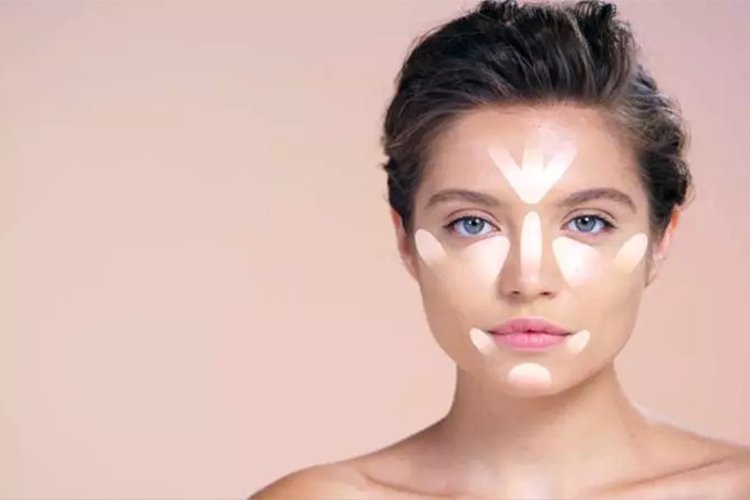
Contouring is a makeup technique that has taken the beauty world by storm in recent years. This technique involves using a combination of light and dark shades of makeup to create the illusion of shadows and highlights on the face, giving it a more defined and sculpted look. While it may seem intimidating at first, with a few tips and tricks, anyone can learn the art of contouring.
The first step in mastering the art of contouring is to choose the right products. You’ll need a matte bronzer or contour powder that’s a few shades darker than your natural skin tone, as well as a highlighter that’s a few shades lighter. You can use cream or powder products depending on your preference, but it’s important to make sure they’re well-pigmented and blendable.

Before you begin contouring, it’s essential to know your face shape. Everyone’s face is different, and each shape requires a slightly different approach. For example, if you have a round face, you’ll want to focus on creating shadows around the jawline and temples to create the illusion of a more defined shape. On the other hand, if you have a square face, you’ll want to soften the edges of your face with contouring.
Before you start contouring, make sure your face is clean and moisturized. Apply your foundation and concealer as usual, making sure to blend well. Once you have your base in place, you can start to contour.
Contouring is all about creating the illusion of light and shadows on the face. Use a matte bronzer or contour powder to create shadows in the areas you want to sculpt, such as the hollows of your cheeks, the sides of your nose, and the jawline. Apply the product in a thin line and blend well with a fluffy brush.
To complete the look, use a highlighter to add dimension and brightness to the areas of your face you want to bring forward. Apply the highlighter to the tops of your cheekbones, the bridge of your nose, and the cupid’s bow. Be sure to blend well so that there are no harsh lines.
One of the most important tips for successful contouring is to blend well. Use a fluffy brush to blend the contour and highlight products together, so there are no harsh lines. The key is to make sure everything looks seamless and natural.

When it comes to contouring, less is often more. It’s essential to start with a light hand and build up the product gradually until you achieve the desired effect. Overdoing it with the contour and highlight can result in a harsh and unflattering look.
Contouring takes practice, so don’t be discouraged if it doesn’t look perfect the first few times. Keep experimenting with different techniques and products until you find what works best for your face shape and skin tone.
When selecting your contour and highlight products, it’s important to consider your skin type. For oily skin, you may want to use a powder contour and highlight to avoid adding any extra shine. For dry skin, a cream or liquid product may work better to prevent the skin from looking flaky or cakey.
Using the right tools is crucial when it comes to contouring. For a natural-looking finish, use a fluffy brush to blend the products seamlessly. A small, angled brush can be helpful when working on more precise areas such as the nose or jawline.
When it comes to contouring, it’s best to build the product gradually. Starting with a small amount of product and building it up slowly will prevent you from going overboard and making the look too dramatic. Remember, you can always add more, but it’s harder to remove too much.
The key to successful contouring is finding the right shade of product for your skin tone. A shade that is too dark or too light can make the look appear harsh or unnatural. Test the product on your skin before committing to a full application to ensure that it blends well and matches your skin tone.

Many people forget to contour their neck when applying makeup, but it can make a big difference in creating a seamless, natural look. Use the same contour shade on your neck as you do on your face to create a more defined jawline and overall sculpted appearance.
Another commonly overlooked area when contouring is the ears. If you have long hair or plan to wear your hair up, be sure to apply contour to your ears to avoid any color discrepancies between your face and ears.
The lighting in which you apply your makeup can have a significant impact on the final look. It’s best to apply makeup in natural light to ensure that you’re applying the right amount of product and blending it well. If natural light isn’t an option, consider investing in a lighted makeup mirror to help you see the contours and highlights more clearly.
For a more natural finish, try blending your contour and highlight with a damp makeup sponge. The dampness of the sponge will help to sheer out the product, giving a more natural-looking finish.
To ensure that your contour and highlight lasts all day, use a setting spray to lock everything in place. This will prevent any product from smudging or fading throughout the day, keeping your look flawless.
In conclusion, contouring is a makeup technique that can completely transform your look, creating a more defined, sculpted appearance. By following these tips and tricks, you can master the art of contouring and create a flawless look every time. Remember to consider your skin type, use the right tools, and build gradually. With practice, you’ll be able to create a beautiful contoured look that will leave you feeling confident and beautiful.